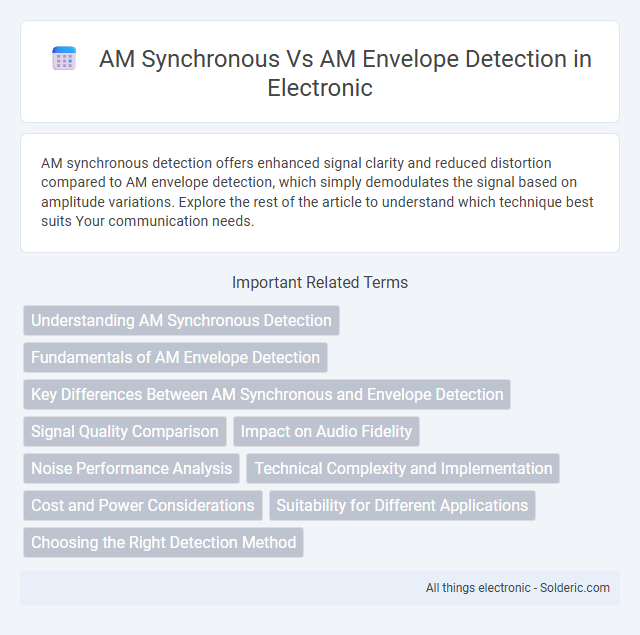AM synchronous detection offers enhanced signal clarity and reduced distortion compared to AM envelope detection, which simply demodulates the signal based on amplitude variations. Explore the rest of the article to understand which technique best suits Your communication needs.
Comparison Table
| Feature | AM Synchronous Detection | AM Envelope Detection |
|---|---|---|
| Detection Method | Coherent detection using a synchronous reference signal | Non-coherent detection using the envelope of the AM signal |
| Complexity | Higher complexity due to oscillator and phase synchronization | Lower complexity; simple diode and RC circuit |
| Sensitivity to Noise | Better noise performance and higher signal-to-noise ratio (SNR) | More sensitive to noise, lower SNR |
| Distortion | Reduced distortion with accurate synchronization | Higher distortion, especially on weak signals |
| Carrier Requirement | Requires a synchronized carrier reference | No carrier reference required |
| Output Quality | High fidelity audio and signal recovery | Moderate fidelity; susceptible to distortion and noise |
| Application | Used in high-performance AM receivers and scientific measurements | Common in simple AM radios and low-cost receivers |
Understanding AM Synchronous Detection
AM synchronous detection improves signal clarity by using a locally generated carrier phase-locked to the incoming AM signal, enabling accurate extraction of the message even in noisy environments. Unlike AM envelope detection, which simply rectifies the amplitude variations and is more susceptible to distortion and noise, synchronous detection tracks the carrier's phase and frequency for precise demodulation. This method significantly reduces fading effects and enhances the signal-to-noise ratio, making it ideal for high-fidelity AM communication systems.
Fundamentals of AM Envelope Detection
AM envelope detection relies on extracting the amplitude variations of the modulated carrier wave to recover the original message signal without requiring a carrier reference, making it simpler and more cost-effective than synchronous detection. This method uses a diode rectifier followed by a low-pass filter to trace the envelope, effectively demodulating signals when the modulation index is low and noise levels are minimal. Your choice of envelope detection hinges on the balance between circuit simplicity and the desired output fidelity, as synchronous detection offers better noise immunity but at increased complexity.
Key Differences Between AM Synchronous and Envelope Detection
AM synchronous detection uses a locally generated carrier signal synchronized with the incoming AM wave to demodulate with high fidelity, preserving both amplitude and phase information. Envelope detection relies on a simple diode and RC circuit to extract the amplitude variations without phase accuracy, making it less complex but more susceptible to distortion in weak or noisy signals. Your choice between these methods depends on the need for signal quality versus simplicity and cost in AM receiver design.
Signal Quality Comparison
AM synchronous detection offers superior signal quality compared to AM envelope detection by accurately demodulating signals with lower distortion and improved noise immunity. It preserves the original amplitude variations of the carrier more effectively, resulting in clearer audio and reduced fading effects. Envelope detection, while simpler and cost-effective, suffers from higher distortion and noise susceptibility, especially in weak signal conditions, leading to degraded audio fidelity.
Impact on Audio Fidelity
AM synchronous detection significantly enhances audio fidelity by accurately demodulating the carrier signal, reducing distortion and noise in the recovered audio compared to AM envelope detection. Envelope detection, while simpler, is more susceptible to noise and signal fading, resulting in lower sound quality and increased distortion. Your choice of synchronous detection will yield clearer and more faithful audio reproduction, especially in challenging reception conditions.
Noise Performance Analysis
AM synchronous detection offers superior noise performance compared to AM envelope detection by coherently demodulating the signal, which reduces the impact of noise and interference on the output. Envelope detection is more susceptible to noise, especially at low signal-to-noise ratios, because it relies on amplitude variations that noise can easily distort. Your choice between these methods should consider the noise environment, with synchronous detection preferred for applications requiring higher fidelity under noisy conditions.
Technical Complexity and Implementation
AM synchronous detection involves mixing the received signal with a locally generated carrier that is phase-locked to the transmitter, requiring precise carrier recovery and complex circuitry or algorithms for synchronization and phase alignment. AM envelope detection uses a simple diode detector to extract the envelope of the modulated signal, making it easier to implement with minimal hardware but less effective in noisy or weak signal conditions. Your choice depends on the trade-off between implementation simplicity and the need for accurate demodulation in varying signal environments.
Cost and Power Considerations
AM synchronous detection typically requires more complex circuitry, resulting in higher cost and increased power consumption compared to AM envelope detection. Envelope detection uses simpler hardware, making it more cost-effective and energy-efficient for battery-powered or low-cost applications. Your choice depends on balancing performance needs against budget and power constraints.
Suitability for Different Applications
AM synchronous detection offers superior noise immunity and signal fidelity, making it ideal for high-quality audio broadcasting and communications requiring accurate demodulation. AM envelope detection, with its simpler circuitry and lower cost, suits applications like commercial AM radio receivers and basic signal monitoring where simplicity and cost-efficiency are prioritized. Choosing between these methods depends on the application's demands for signal clarity, complexity, and budget constraints.
Choosing the Right Detection Method
Choosing the right AM detection method depends on your signal quality and application requirements. AM synchronous detection offers improved noise performance and better fidelity by multiplying the received signal with a locally generated carrier, making it ideal for weak or distorted signals. Your choice favors synchronous detection for enhanced accuracy, while envelope detection provides simplicity and lower cost for strong, clean AM signals.
AM synchronous vs AM envelope detection Infographic

 solderic.com
solderic.com